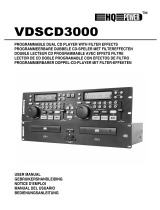
1
Table of contents
Warning ............................................................................................................................................................................... 2
Unpacking Instructions ................................................................................................................................................. 2
Safety Instructions ......................................................................................................................................................... 2
Operating Determinations .......................................................................................................................................... 3
Return Procedure .......................................................................................................................................................... 4
Claims .............................................................................................................................................................................. 4
Description of the device ................................................................................................................................................. 5
Features .......................................................................................................................................................................... 5
Overview ........................................................................................................................................................................ 5
Frontside.......................................................................................................................................................................... 7
Backside ......................................................................................................................................................................... 7
Installation ........................................................................................................................................................................... 7
Set Up and Operation ....................................................................................................................................................... 7
Functions ............................................................................................................................................................................. 8
Operations ........................................................................................................................................................................13
Loading a CD ...........................................................................................................................................................13
Unloading a CD .......................................................................................................................................................13
Selecting tracks ........................................................................................................................................................13
Starting playback ....................................................................................................................................................13
Stop playback ..........................................................................................................................................................14
Pausing .......................................................................................................................................................................14
Setting a cue point ..................................................................................................................................................14
Setting a hot cue Point ...........................................................................................................................................14
Cueing .......................................................................................................................................................................14
Frame search ............................................................................................................................................................15
Scanning ....................................................................................................................................................................15
Time display ...............................................................................................................................................................15
Changing pitch of the song ..................................................................................................................................15
Program play ............................................................................................................................................................16
Loop play ..................................................................................................................................................................16
Set auto loop length ...............................................................................................................................................16
Auto loop play ..........................................................................................................................................................16
Reloop ........................................................................................................................................................................16
Creating a hot loop.................................................................................................................................................17
Relay play (two CD players) ..................................................................................................................................17
Before switching off the power .....................................................................................................................................17
CDs ................................................................................................................................................................................17
Precaution on storage ...............................................................................................................................................17
Maintenance ....................................................................................................................................................................18
Troubleshooting ...............................................................................................................................................................18
Product Specifications ....................................................................................................................................................19
Dimensions ........................................................................................................................................................................20
Notes ..................................................................................................................................................................................21





















